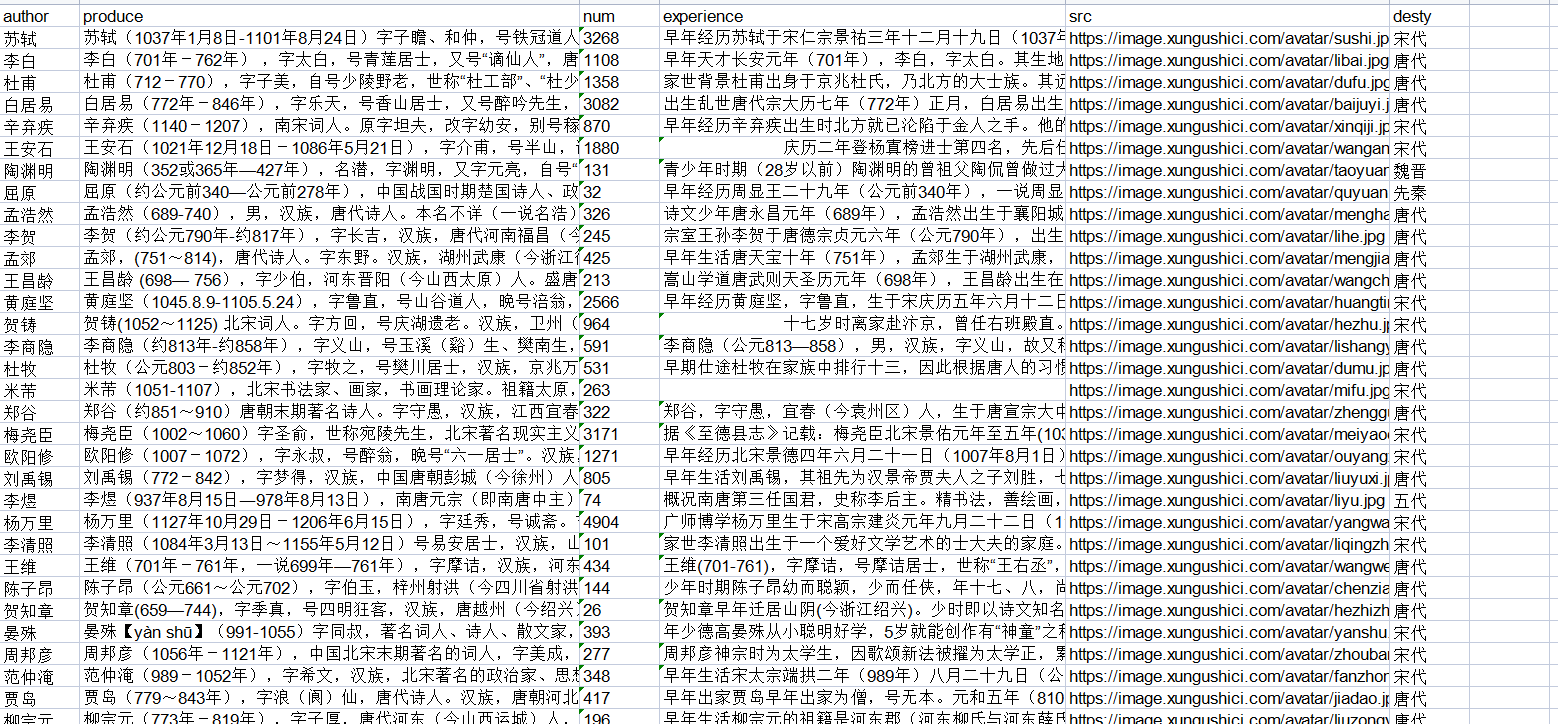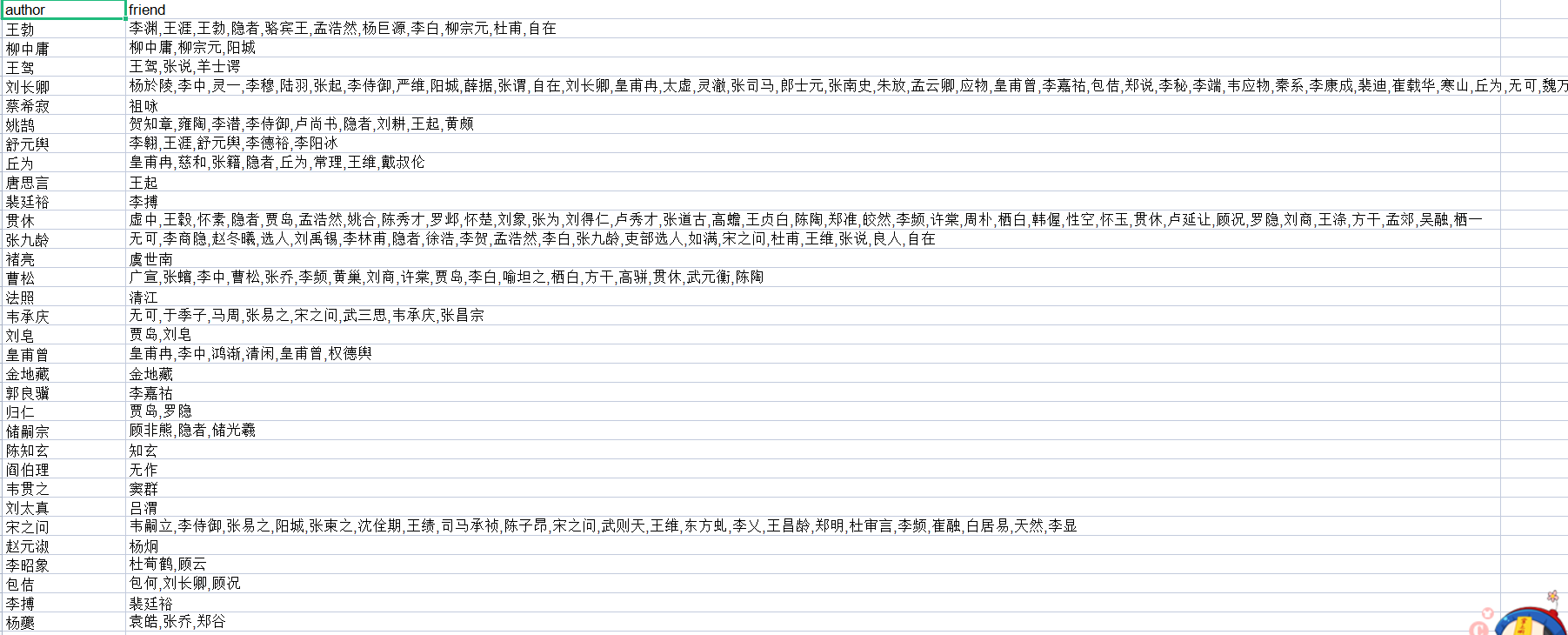诗人信息重新收集
收集所有诗人
诗人图片与朝代,之前收集的诗人只有2000多个,是因为之前收集的诗人有生平,而其他诗人没有,故没有收集到
这次收集所有诗人,都有个人介绍。从个人介绍中也可提取出有用的信息。
经过此次收集,共收集到20088个诗人
import requests
from bs4 import BeautifulSoup
from lxml import etree
import re
headers = {'user-agent':'Mozilla/5.0 (Windows NT 10.0; Win64; x64) AppleWebKit/537.36 (KHTML, like Gecko) Chrome/74.0.3729.131 Safari/537.36'}#创建头部信息
pom_list=[]
k=1
for i in range(1,2010):
url='https://www.xungushici.com/authors/p-'+str(i)
r=requests.get(url,headers=headers)
content=r.content.decode('utf-8')
soup = BeautifulSoup(content, 'html.parser')
hed=soup.find('div',class_='col col-sm-12 col-lg-9')
list=hed.find_all('div',class_="card mt-3")
origin_url='https://www.xungushici.com'
for it in list:
content = {}
# 1.1获取单页所有诗集
title = it.find('h4', class_='card-title')
poemauthor=title.find_all('a')[1].text
desty=title.find_all('a')[0].text
#print(poemauthor+"+"+desty)
#获取诗人图像
if it.find('a',class_='ml-2 d-none d-md-block')!=None:
src=it.find('a',class_='ml-2 d-none d-md-block').img['src']
else:
src="http://www.huihua8.com/uploads/allimg/20190802kkk01/1531722472-EPucovIBNQ.jpg"
content['src']=src
href=title.find_all('a')[1]['href']
#对应的诗人个人详情页面
real_href = origin_url + href
#诗人简介及诗集个数
text = it.find('p', class_='card-text').text
#诗人的诗集个数
numtext = it.find('p', class_='card-text').a.text
pattern = re.compile(r'd+')
num=re.findall(pattern, numtext)[0]
#进入诗人详情页面
r2=requests.get(real_href,headers=headers)
content2=r2.content.decode('utf-8')
soup2 = BeautifulSoup(content2, 'html.parser')
ul=soup2.find('ul',class_='nav nav-tabs bg-primary')
if ul!=None:
list_li=ul.find_all('li',class_='nav-item')
exp = ""
for it in list_li:
if it.a.text=="人物生平" or it.a.text=="人物" or it.a.text=="生平":
urlsp=origin_url+it.a['href']
r3 = requests.get(urlsp, headers=headers)
content3 = r3.content.decode('utf-8')
soup3 = BeautifulSoup(content3, 'html.parser')
list_p=soup3.select('body > div.container > div > div.col.col-sm-12.col-lg-9 > div:nth-child(3) > div.card > div')
for it in list_p:
exp=it.get_text().replace('
','').replace(' ','').replace('
','')
content['author']=poemauthor
content['produce']=text
content['num']=num
content['desty'] = desty
content['experience'] = exp
pom_list.append(content)
else:
content['author'] = poemauthor
content['produce'] = text
content['num'] = num
content['desty'] = desty
content['experience'] = "无"
pom_list.append(content)
print("第"+str(k)+"个")
k=k+1
import xlwt
xl = xlwt.Workbook()
# 调用对象的add_sheet方法
sheet1 = xl.add_sheet('sheet1', cell_overwrite_ok=True)
sheet1.write(0,0,"author")
sheet1.write(0,1,'produce')
sheet1.write(0,2,'num')
sheet1.write(0,3,'experience')
sheet1.write(0,4,'src')
sheet1.write(0,5,'desty')
for i in range(0,len(pom_list)):
sheet1.write(i+1,0,pom_list[i]['author'])
sheet1.write(i+1, 1, pom_list[i]['produce'])
sheet1.write(i+1, 2, pom_list[i]['num'])
sheet1.write(i+1, 3, pom_list[i]['experience'])
sheet1.write(i + 1, 4, pom_list[i]['src'])
sheet1.write(i + 1, 5, pom_list[i]['desty'])
xl.save("author3.xlsx")
存储效果

诗人关联人物
通过诗集来找到关联人物
先找唐代相互关联的诗人,步骤如下:
通过对诗名,诗文赏析,写作背景,来对作者(也就是诗人)进行分析,找出其中包含的其他诗人的名字。存储到一个列表
因为会涉及到多首诗,都是同一个作者,因此,涉及到字典,列表合并,去重
列表合并:list+=list2
列表去重:a=list(set(a))
在考虑是否是相关的作者时,有以下考察点:
其一:通过内容去检索所有诗人,找到诗人库中包含的关联诗人
其二:找到关联诗人后,判断是否和作者同一个朝代
其三:还可判断是否在作者的出生年月内(未实现,部分诗人出生年月不详)
import numpy
import xlwt
import pandas as pd
ans=[]
def read_author():
file="author3.xlsx"
data=pd.read_excel(file).fillna("无")
author=list(data.author)
all_desty=list(data.desty)
experience=list(data.experience)
dict_exp={}
dict_des={}
for i in range(len(author)):
dict_exp[author[i]]=experience[i]
dict_des[author[i]]=all_desty[i]
#去重
author=list(set(author))
file2="tang.xlsx"
tang=pd.read_excel(file2).fillna("无")
author_name=list(tang.author)
t_desty=list(tang.desty)
new_author=list(set(author_name))
dict={}
for it in new_author:
dict[it]=[]
title=list(tang.title)
appear=list(tang.appear)
back=list(tang.background)
for i in range(len(author_name)):
name = author_name[i]
if name=='佚名':
continue
content=title[i]+appear[i]+back[i]
friend=[]
for j in range(len(author)):
if content.find(author[j])!=-1 and dict_des[author[j]]=="唐代":
friend.append(author[j])
#print(name+": "+str(friend))
dict[name]+=friend
dict[name]=list(set(dict[name]))
dict[name]=dict[name]
print("--------------------ans--------------------------")
ans_author=[]
ans_friend=[]
for it in dict:
if dict[it]!=[]:
ans_author.append(it)
ans_friend.append(','.join(dict[it]))
print(it+":"+str(dict[it]))
xl = xlwt.Workbook()
# 调用对象的add_sheet方法
sheet1 = xl.add_sheet('sheet1', cell_overwrite_ok=True)
sheet1.write(0, 0, "author")
sheet1.write(0, 1, 'friend')
for i in range(0, len(ans_author)):
sheet1.write(i + 1, 0, ans_author[i])
sheet1.write(i + 1, 1, ans_friend[i])
xl.save("friend.xlsx")
if __name__ == '__main__':
read_author()
效果
里面friend有的包括原作者,之后在对其清洗
